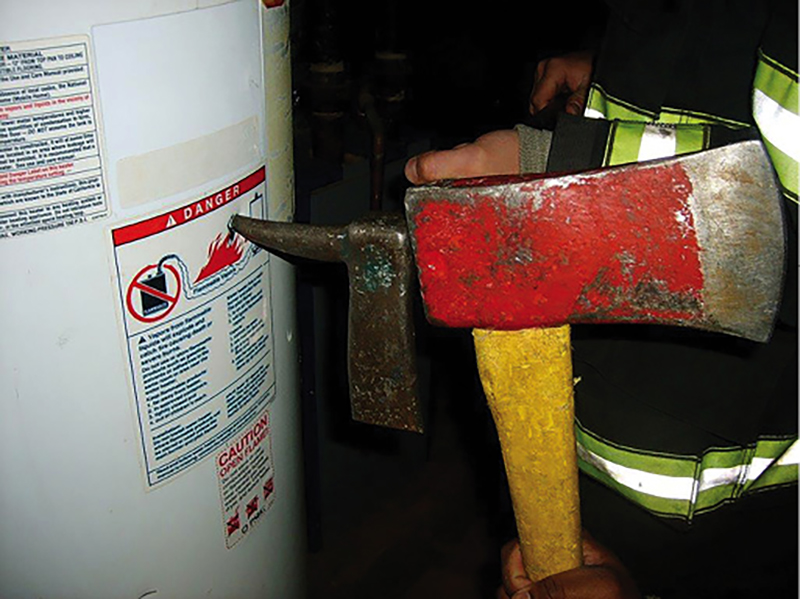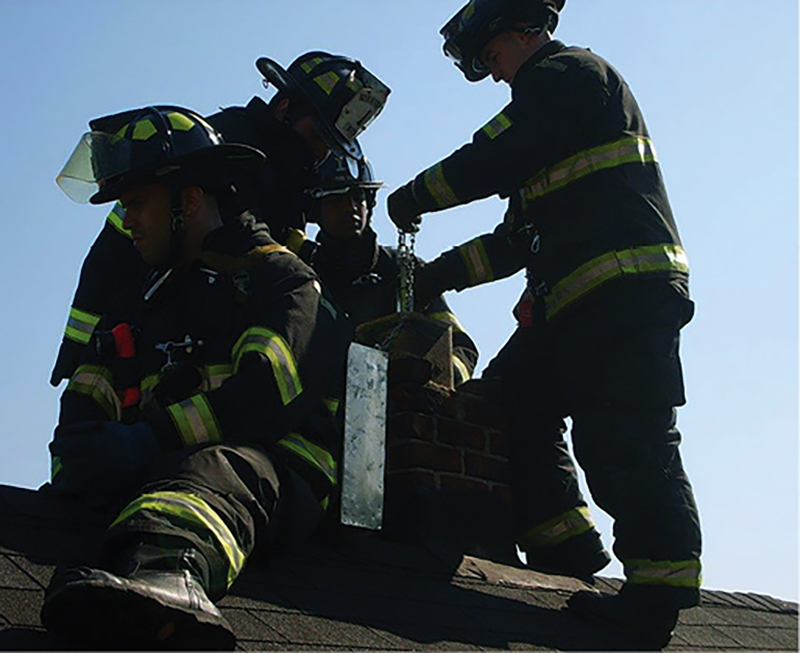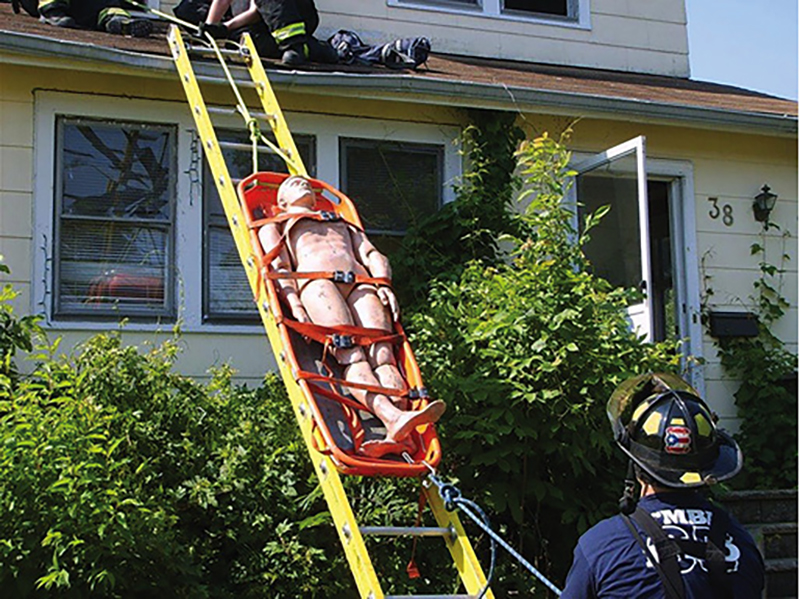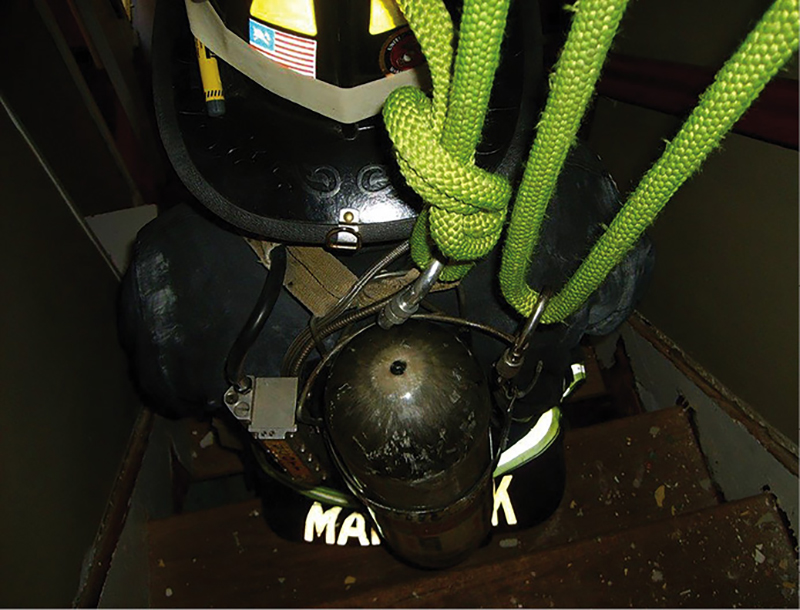By JAMES A. KIRSCH
One of the best resources a fire department can have for training is an acquired structure. Although this donated property is usually a residential dwelling, some departments have been lucky enough to use donated commercial properties of larger sizes or structures with multiple floors. Such buildings can be extremely valuable in teaching firefighters new skills or reinforcing the skills of more experienced firefighters, but the building’s availability is usually limited. As such, the value of an acquired structure should be realized so that an extended training period that allows for as many learning scenarios as possible can take place.
- Fire Training in Acquired Structures
- Maximizing Training Evolutions in an Acquired Structure
- Getting the Most Out of Acquired Structure Live Burns
- Necessary, Dangerous, or Both: Live Fire Training in Acquired Structures
This article will show how donated structures can be used for a multitude of nonlive-fire-based drills before the building is demolished by the owner or burned down in training when allowed.
Building Basics
Many times, departments will hold one day of training or several night drills, with the main operations being centered on search and rescue exercises, maybe some hose stretching, and then breaking windows and cutting a roof. Although these practical operations should be covered, a plan that leaves the more “destructive” drills toward the end of training period will allow the building to be used to train members to increase their skill set in other firefighting duties.
The property needs to be correctly donated by the building owner as well being properly prepared for safety so the risks to firefighters operating in and around the property are reduced or eliminated. This means the fire department must be able to produce a “hold-harmless” agreement, properly vetted and accepted by the legal department of the authority having jurisdiction and signed off on by both fire department representatives and the property owner (not the builder, demolition person, or someone else claiming to represent the owner). This agreement should also include information on what the expected condition of the building will be at the end of the training period and any other information detailing which parts of the building or items on the property are not to be damaged or touched. Additionally, it should include proof of the cancellation of homeowner’s insurance on the donated structure.
From a safety standpoint, an instructor or officer with the requisite knowledge for operating in acquired structures should do a walk-through of the property before any other department members go to the location. Excessive damage, flooding or mold issues, insect or vermin infestation, and problems caused by the homeless may all be reasons to refuse the property because of the amount of cleanup that would be needed and the time required to make the building safe to work in. Although all the utilities should be disconnected and removed, a letter from an exterminator showing that the property is vermin-free may be requested by your jurisdiction; if so, the fire department should confirm that structure has passed this requirement.
The best way for the fire department to make sure nothing is missed during the walk-through is to use a checklist. If your department does not currently have a checklist, use the checklists and documentation examples available in National Fire Protection Association 1403, Standard on Live Fire Training Evolutions, which requires using a checklist that, from a safety standpoint, will guide your department to better prepare the donated property so dangerous situations can be eliminated and risks to members reduced while they operate. This will be very helpful when firefighters are in training scenarios with limited visibility or when artificial smoke is used. This checklist will cover problem areas that may exist both inside and outside the structure.
Looking for a Structure
How does your department get the word out to the public that it would like to use their property for training? Web sites and social media accounts need to have property owners seek out your department for information, which may not lead to your department getting buildings before they are demolished. One good avenue is to find the municipal office in your jurisdiction that issues demolition permits; many times, it’s the Building Department. Having a good relationship with Building Department staff can make their hold-harmless agreements available immediately to property owners who come in seeking a demolition permit. If the staff is uncomfortable with such an arrangement, see if the fire department can give out contact information with the permit or ask if the permit seeker would like to be contacted by the fire department.
We must consider two things here. First, if the property owner agrees to donate the property, the fire department contact must follow up with him as soon as possible to conduct a walk-through and confirm that the hold-harmless agreement and other paperwork are completed. Second, the building can be taken down even if the training period has not timed out according to the dates set in the hold-harmless agreement. It is important to understand that the property owner’s—not the fire department’s—time frame should be followed. Construction machinery may become available soon after the permit is issued, with the structure in compliance with the regulations needed to take it down. This machinery will cost the owner money if it is parked and idle on the site. Asking the owner to hold off taking the structure down will probably mean not getting another donation from that owner and possibly being turned down for additional properties if owners or contractors feel pressured into holding up the demolition process.
After the Compliance
With the property being made safe enough in which to operate, the department training officer or company officers should put together a plan on how to use the structure. The type of training your department wants to cover, coupled with a plan on how to achieve it while keeping the more destructive training drills for the end of the training period, must be worked out. If there are any garages or small outbuildings on the property that you can use, they should also be included in training plans; confirm that they have been made safe.
For example, it makes no sense to have a new firefighter practice roof ventilation on a low, flat garage roof if rotted decking may cause that firefighter to fall partially or completely through that roof. This is a good time for instructors and officers to walk through the property to see the opportunities the structure offers and set a training evolution timeline.
This is also the time to confirm how the structure will be made safe and nonaccessible to possible trespassers after each company finishes drilling. For this reason, do not break or damage the basement and first-floor windows and doors during the early part of the training period. Leave forcible entry of the exterior doors to the end unless they can be properly secured.
All the instructors and company officers, as well as the department safety officer, should be on the same page about making the building safe for the next incoming crew. So, if a company wants to do firefighter lift-outs from the floor below, choose a room that has an interior door that you can close so no one inadvertently walks into the hole that was made. If required, secure the door with a nail, use caution tape across the door, or spray-paint a message on the door that the floor is open. If the hole has been made in an open room or below a window, take down an interior closet door and nail it across the opening so it can’t be moved easily and, again, mark the floor or other location that will advise people that the floor is open. Remember, remove any portions of floorboards (or roof decking) that have been cut to a safe location such as a closet; if those cut pieces contain sharp edges or nails, this will reduce the possibility of a puncture wound if they are stepped on or crawled over. Also, remove broken pieces of glass from window frames. Use what the structure already contains such as closet doors, shelving, or even parts of drawers to nail across the window openings so they are secured.
Beginning the Training
A good way to start the training is by having new officers or those who may be in line for promotion conduct size-ups. This includes learning to speak correctly on the radio, starting with descriptions of the structure’s overall size, construction, and occupancy, while conducting the 360° walk-around to correct communication deficiencies so those participating can learn from their mistakes. Add in artificial smoke, “residents” at windows, or other twists that would require additional transmissions so the incident commander-in-training learns to send the proper information to the incoming units.
Using artificial smoke, smoke ejectors, and positive pressure ventilation fans as well as conducting hands-on drills about positive and negative ventilation and discussing flow paths will cause no damage to the structure.
Give newer members hands-on experience for the routine emergencies to which all departments respond. If appliances and gas lines remain in the home, go over how to track down leaks, the use and maintenance of the air monitors, and how to track gas lines back to the meter area (which will probably have been removed). Prepare members for electrical emergencies by having firefighters practice removing the outlets or light fixtures that will still be found around the property.
With a commercial structure, make issues with fluorescent lighting and ballasts part of the drill. Here, you can have students demonstrate finding the circuit breaker panel; correctly cutting, separating, and taping wiring; and checking for “extension” for a fire outside an electrical outlet box and in the wall. In addition, tie in how to use tools such as continuity testers and lock-out/tag-out kits, allowing members with limited knowledge of electrical emergencies to get practice. Use any other appliances left in the building as training props for calls that may involve burned-out motors, damaged drive belts, or electrical arcing. You can also use these appliances to familiarize members with the smaller hand tools that can open and remove the appliance housing.
In all likelihood, the donated property will still contain a heating plant. Use whatever is there to practice responses that teach newer members what to do to control the problem. If the building contains an oil burner, the drill should involve shutting down the fuel supply, knowing the location of the fuel tank, oil burner blowbacks, determining the correct extinguisher to use, and if and why we need to stretch a handline if the dislodged access door to the fire box is causing fire to enter the basement. Senior members can also add in a “lessons learned” talk about calls to which they have responded involving furnaces and boilers, so you can pass on information on how to properly investigate and mitigate heating plant emergencies to the younger members.
Topics and Drills
Topics to cover include how to shut down fuel at the unit, meter, or tank; removing the electrical source; dealing with flooded units or dislodged, damaged, or blocked flue pipes; and carbon monoxide issues. You can also cover similar issues with hot water heaters, chimneys, and fireplaces. Do you want to set up a quick and easy drill for hazardous materials leaks? Use an ax and the point of a halligan tool to put a hole in the side of the hot water heater and have members practice stopping the leak with a patching and plugging kit (photo 1). Also, get up on the roof and deploy whatever tools your department has to clear blocked chimneys; discuss all the steps of extinguishing a fire in the chimney or flue (photo 2).

(1) A firefighter creates an easy hazmat leak prop by using an ax and halligan tool to put a hole in the hot water heater. Moving the hole lower on the water heater will increase the pressure of the leak. Firefighters can practice plugging the leak. (Photos by author.)

(2) The firefighter on the left has carried chimney chains in a backpack to the roof where the officer and other firefighters practice clearing chimney blockages.
With the building still in good condition and its roof and windows still intact, you can start drills that require a smoke condition. Cover subjects that follow the plan that was established, whether they cover search and rescue, stretching hoselines, feedback-assisted rescue, or other rapid intervention drills that do not damage the building and allow it to be properly secured prior to leaving the location.
This would be a good time to drill on ladder raises, making sure that all the ladders on the truck are removed and set up. Ladder drills can incorporate proper lifts and carries as well as moving equipment and hoselines up and onto roofs. This is also a great time to practice and reinforce knot-tying skills by using ropes to lift or lower equipment to the roof or removing mannequins in stokes baskets for simulated removals of patients from heights (photo 3).

(3) Firefighters practice removing victims from a roof using simple mechanical advantage and an anchor point in the window and the ladder as a slide.
Conduct training drills that may cause damage to interior walls or doors such as wall breaching or other “mask confidence” course-type drills while the outer envelope of the donated building is still in good shape; this is to keep the weather out of the training space while still making sure the structure can be easily secured. You can also cut interior doors to rooms to create an opening near the bottom, creating a low overhead obstruction through which the firefighter must maneuver.
If you are to incorporate areas of the building into a mask confidence course using such space behind a knee wall or another area where a firefighter may be temporarily out of sight from the training officer, check that area first to confirm it is safe to crawl through and that there is an easy way to get to and remove that member if the need arises. Other obstructions can usually be made by using items found in the building, such as coaxial cable and discarded furniture.
When practicing pulling ceilings or conducting other overhaul drills, the opening up should be done with a clear purpose. Also teach members how the tools for these evolutions work by getting them off the rig. Discuss important lessons with them such as which hook works best when removing the ceiling cover as well as how to work in conjunction with an engine company that is putting out extending fire. Other topics to cover include where to open up and why, how pipe chases run and how fire will extend, and when to stop pulling the ceiling.
Practice with Unfamiliar Tools
Donated homes are the perfect place to teach students how to properly trim floors and wall moldings to expose hidden fire in those spaces or burning sash-weight window ropes in old-style construction. If your department has a reciprocating saw, get it out so the firefighters can practice cutting gypsum board or wood and change blades to cut the available pipes.
Members cannot expect to be proficient in tools with which they have very little or no experience. Donated properties allow for them to practice and gain competency with these tools whether the tools can be considered “newer” to fire service work such as battery-operated reciprocating saws or “older” such as Bresnan distributors and cellar pipes.
Many departments are experienced with firefighter through-the-floor or other types of lift-out drills. Donated properties are a good place to practice these skills as we start to further take the building apart. As always, safety and education are key to operating so no one gets hurt. Where required, use safety ropes and cushioned mats, when available. This includes drills covering practical exercises on ladder bailouts and using ladders as a high point to remove a down firefighter (or use a mannequin instead).
Practice removing closet doors as well as most interior room doors with an ax or other tool that will allow the door to be removed in several seconds with a quick quarter-turn of the tool by the firefighter, stripping the screws from the jamb; this is a good skill to have—the removed door can eventually be nailed over floor openings or removed windows. The door to any room that may have a hole in the floor should remain in place, nailed shut as needed, and marked that an opening exists in the floor of that room. Also leave in place any door to a room that may be getting used for vent-enter-isolate-search (VEIS) practice.
Practical exercises that involve breaking windows or removing windows such as VEIS or ladder bailouts will require security to prevent entry or keep the artificial smoke in if additional drills are to take place. If the fire department brings plastic sheeting to the location, staple it in place to minimize smoke leakage at windows that need to be reused. Also use items found at the location to block up windows prior to leaving the site; these include closet doors, shelving, or anything else found that will work to prevent trespassing.
Donated properties also allow your department to practice rescue techniques for trapped firefighters that may be more complex and thought provoking such as roof removals or removals from weakened staircases and which may require a high point to assist in lifting (photo 4). Block or tape off an area with caution tape for drills that compromise stairs so other members are warned to stay away.

(4) In this scenario, firefighters practice removing a trapped firefighter from a weakened and damaged staircase.
Acquired structures also give your department a location that can incorporate training props assembled by department members if there are specific training scenarios that need to be practiced, such as heavily reinforced doors or window coverings. Again, the fire department must confirm that that the property is completely secured after opening any windows on the first floor or basement level or after the front and rear entry doors have been forced.
The fire department should always be cognizant of the concerns of neighbors bordering the donated property. You must secure all debris created by the drill (roof shingles, insulation, cut roof decking, and so on) in the building so it does not end up on the neighbors’ yard. If a drill calls for flowing water, confirm that the runoff will remain on the donated property; don’t block adjacent driveways. Also consider that any drill using roof saws should stop at a designated time if the municipality has a noise curfew. Additionally, the department must confirm that the building was returned to the owner within the scope of conditions that were spelled out in the hold-harmless agreement.
These are just some of the steps a fire department can take that will address owners’ and neighborhood concerns and help your department to acquire additional donated properties in the future.
JAMES A. KIRSCH served for 31 years with the Bergenfield (NJ) Fire Department, where he retired as a captain. He is also a former volunteer chief and department training officer. Kirsch is a New Jersey state-certified drill ground instructor, incident manager, and fire prevention official. He has authored several articles for Fire Engineering, co-authored Fire Engineering’s Study Guide for Firefighter I and II, and created the DVD Live Fire Training in Acquired Structures. Kirsch has a master’s degree in public administration and is a graduate of the National Fire Academy’s Executive Fire Officer program.

